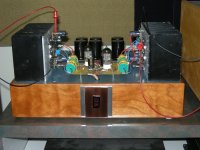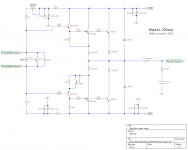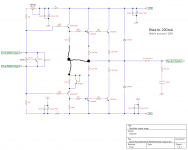Using the Aikido 6Au6/5687 as the line stage driving the module I was looking at less than .76 at full power with NO feedback. Very clean sounding setup. This is a case where the ear is a better judge than the distortion analyzer. You would swear the amp was at .002 or less distortion. To be honest the 6au6 isn't the cleanest of the Aikido's. I'm sure that better measurements would result from a different line stage such as the 6FQ7/5687.
Well well well. Will you look at that!  A circlotron.
A circlotron.
One thing, the bias for the mosfets will vary with the supply voltage. Also, what I like to do (but not absolutely necessary) is to use a transformer with a single centre-tapped winding and earth the centre tap and put each end of the trans via a dc blocking capacitor to the left end of each gate resistor. This see-saw transformer forces the gate drive to be absolutely symmetrical but opposite.
Big n-channel mosfets are easy to get, rugged and cheap. In class A the square-law gate voltage / drain current relationship of the two mosfets, one going up, the other going down, complement each other fairly closely. Fairly easy to get ~0.1 ohm output impedance without global feedback. Looks good if you ask me
Edit --> I'm not so sure that connecting the 2 x 22k & 2 x 1k resistors to the driver cathode resistor instead of ground is such a good idea. Any imbalance in the driver halves will alter the instantaneous voltage on this cathode resistor and that will alter the drive of both halves of the output stage in the =same direction=. They will pull against each other. Not good.
 A circlotron.
A circlotron.One thing, the bias for the mosfets will vary with the supply voltage. Also, what I like to do (but not absolutely necessary) is to use a transformer with a single centre-tapped winding and earth the centre tap and put each end of the trans via a dc blocking capacitor to the left end of each gate resistor. This see-saw transformer forces the gate drive to be absolutely symmetrical but opposite.
Big n-channel mosfets are easy to get, rugged and cheap. In class A the square-law gate voltage / drain current relationship of the two mosfets, one going up, the other going down, complement each other fairly closely. Fairly easy to get ~0.1 ohm output impedance without global feedback. Looks good if you ask me
Edit --> I'm not so sure that connecting the 2 x 22k & 2 x 1k resistors to the driver cathode resistor instead of ground is such a good idea. Any imbalance in the driver halves will alter the instantaneous voltage on this cathode resistor and that will alter the drive of both halves of the output stage in the =same direction=. They will pull against each other. Not good.

Hi Burnedfingers,
thanks. Could you however say more ?
Thanks
thanks. Could you however say more ?
- How much current at idle ?
- How much power in Class A ?
- Did you use the devices Wim proposes in the schema or some of the variations ?
- How much do you would rate the speed of the devices you used ?
- What about the PSU ? regulated, unregulated ?
- What about the PSRR ?
Thanks
I tested the amplifier probably under the most unfavorable conditions because it had no fancy power supply but one borrowed from a piece of commercial audio gear. I ran the amplifier with an unregulated supply of plus and minus 40 volts with 9,000 mfd filter caps with no by passes and nothing fancy added. The amplifier was put together with all the parts as stated by Wim in order to give a fair idea as to the performance of the amplifier. The amplifier was biased at 33mv across R14 per the instructions. There might be some to be gained by setting the bias a little stronger but then again one needs to think along the lines of product life as well. I will also say I ran the amps with less than stated bias and they still sounded sweet.
I believe that Wim has done his home work and has presented a good viable product well worth your consideration. I will also point out that one should purchase GOOD quality pots instead of the cheap ones I threw in there and they won't have to be replaced like I did mine.
There is only one Quasi-complementary amplifier I have ever liked before this amp and that was an ALtec 9440.
Note*
I used the 2SC5200's for outputs and the 2SC2073 and 2SA940 for drivers and the BD679 bias transistor.
I will also mention that I am not affiliated with Wim in any manor nor am I receiving any consideration for my report on this amplifier. I am giving it a fair trial as I would with anything that was sitting before me.
I believe that Wim has done his home work and has presented a good viable product well worth your consideration. I will also point out that one should purchase GOOD quality pots instead of the cheap ones I threw in there and they won't have to be replaced like I did mine.
There is only one Quasi-complementary amplifier I have ever liked before this amp and that was an ALtec 9440.
Note*
I used the 2SC5200's for outputs and the 2SC2073 and 2SA940 for drivers and the BD679 bias transistor.
I will also mention that I am not affiliated with Wim in any manor nor am I receiving any consideration for my report on this amplifier. I am giving it a fair trial as I would with anything that was sitting before me.
Hi Burnedfingers,
thanks.
You insist on the sweetness of the Nishiki amplifier. However what I need to understand is how much other qualities of an amplifier are there.
I speak of terms like
Thanks
thanks.
You insist on the sweetness of the Nishiki amplifier. However what I need to understand is how much other qualities of an amplifier are there.
I speak of terms like
- timbric precision
- image reconstruction (depth, width, "air among instruments")
- impact and bass extension
- bass control
- fluidity
- transparency
Thanks
teodorom
What you ask is my interpretation of the hybrid amplifier so I will do my best to answer honestly. I haven't listened to a solid state amplifier in a while since I got hooked on tubes.
To make a fair judgement I pulled out what I consider to be a very good sounding set of mono block solid state amplifiers and used the same line stage my 6AU6/5687 with them and auditioned the same music. Narurally you cannot expect a small amp to keep up in the bass department with amplifiers putting out 250 watts a channel. I do however find the bass was very quick and tight on the Hybrid amplifiers and that is a quality I look for in a very good solid state amplifier. I also found the Hybrid amplifiers less tiring to listen to and having very good image. The image reconstruction(depth,width, air among instruments) might be a factor more controlled by the line stage driving the Hybrid amplifier. I found the reconstruction like I pointed out earlier to be uncolored in nature. I'm sure they will probably take on some characteristics of the line stage providing the signal to the Hybrid section.
I found the Hybrid amps could play quite loud without straining themselves. They were comfortable with Jazz and rock and roll. I don't have any classical anymore in which to try. I do however feel they would do fine with it too.
What you ask is my interpretation of the hybrid amplifier so I will do my best to answer honestly. I haven't listened to a solid state amplifier in a while since I got hooked on tubes.
To make a fair judgement I pulled out what I consider to be a very good sounding set of mono block solid state amplifiers and used the same line stage my 6AU6/5687 with them and auditioned the same music. Narurally you cannot expect a small amp to keep up in the bass department with amplifiers putting out 250 watts a channel. I do however find the bass was very quick and tight on the Hybrid amplifiers and that is a quality I look for in a very good solid state amplifier. I also found the Hybrid amplifiers less tiring to listen to and having very good image. The image reconstruction(depth,width, air among instruments) might be a factor more controlled by the line stage driving the Hybrid amplifier. I found the reconstruction like I pointed out earlier to be uncolored in nature. I'm sure they will probably take on some characteristics of the line stage providing the signal to the Hybrid section.
I found the Hybrid amps could play quite loud without straining themselves. They were comfortable with Jazz and rock and roll. I don't have any classical anymore in which to try. I do however feel they would do fine with it too.
topicreader said:Hello!
I'm also very interested in this thread because I would like to build a hybrid amplifier.
This schematic was published in a hungarian DIY book.
An externally hosted image should be here but it was not working when we last tested it.
The tube stage stem from the famous Williamson amplifier with 2 6SN7 tube, and after the MOSFET part is very simple. The book's author wrote that he had built it and its sound was very good. I would like to use rather in A-class accordingly I have to decrease the supply voltage between +/- 12-15V.
HI
Can you show all information of this schematic ?
thx
Hello DIGORA!
I'm in trouble because the book is written in hungarian language of course, despite of it I can send the original parts of the book about the hybrid amplifier. The book I have is scanned so its format is .jpg. At the moment my desktop PC is out of order (motherbord broke down) and its HDD has the book. I will bring here in my workplace the HDD and after it I will be able to send the book this week.
If you would like a translated version of the article I need more time because my english is poor.
Anyway I simulated the circuit, it worked well and you can see also this schematic in my page. Actually I know that the simulation is not the real circuit , but the book's author wrote that they were build and worked very well.
, but the book's author wrote that they were build and worked very well.
web.axelero.hu/sakkmatt73/kepek/Agoston_szimmetrikus_hibrid.gif
It doesn't content the zener diodes on the MOSFETs.
I wrote in my earlyer post that the schematic based on famous Williamson tubes amplifier. Here is the schema, compare the Williamson amp with the this hybrid amp.
Williamson tube amp
I think the input and the driver stage of the amplifiers are very similar to each other.
Thanks
efGyuri
I'm in trouble because the book is written in hungarian language of course, despite of it I can send the original parts of the book about the hybrid amplifier. The book I have is scanned so its format is .jpg. At the moment my desktop PC is out of order (motherbord broke down) and its HDD has the book. I will bring here in my workplace the HDD and after it I will be able to send the book this week.
If you would like a translated version of the article I need more time because my english is poor.
Anyway I simulated the circuit, it worked well and you can see also this schematic in my page. Actually I know that the simulation is not the real circuit
web.axelero.hu/sakkmatt73/kepek/Agoston_szimmetrikus_hibrid.gif
It doesn't content the zener diodes on the MOSFETs.
I wrote in my earlyer post that the schematic based on famous Williamson tubes amplifier. Here is the schema, compare the Williamson amp with the this hybrid amp.
Williamson tube amp
I think the input and the driver stage of the amplifiers are very similar to each other.
Thanks
efGyuri
nikwal said:I would build it with mu-followers,.. hmm in fact i did a few years ago also with 6N1P sounded pretty ok but imho you need at least a little global feedback..
I used irf710 on plus and then both sides of 6n1p in parallell, that worked pretty ok..
Do you have a diagram ?
thx
I've my NIshiki completed last couple days and it was playing quite happily with my open baffle H frame. It sounds wide and good at almost every range at start. It's power could drive the H frame to the very best and the lower spectrum of this amp is honestly present.
I'm really happy that I almost don't have to buy anything to make this amp. seems like a bonus to me.
As post, I start out with GE6189, Pcc88 and settle with 6N1P.
I'm really happy that I almost don't have to buy anything to make this amp. seems like a bonus to me.
As post, I start out with GE6189, Pcc88 and settle with 6N1P.
Attachments
I've the Nishiki running for almost 20 hrs now with 6N1P. It's very stable and sounds better after heating up (32 C on my heatsink ). Sounds are balance with a touch warm in the mids. Highs are with delicate details like microscope. Almost every soprano I like is singing good with this amp. I especially like playing orchestral music with it. The lowest spectrum are with authority and punchy. Live music is also good, and I can almost touch the performing stage when playing with - Patrica Barber live in Paris.
The only thing I could complain is the noise from the 6N1P so unbearable that I should go find another low nose tube somewhere, and or raise the heater to 7v and try my belove telefunken PCC88 but it's so expensive that I almost don't want to touch them.
Many thanks to the author for sharing his design. And ......for sure I'll try his other design with CCS in the later day.
The only thing I could complain is the noise from the 6N1P so unbearable that I should go find another low nose tube somewhere, and or raise the heater to 7v and try my belove telefunken PCC88 but it's so expensive that I almost don't want to touch them.
Many thanks to the author for sharing his design. And ......for sure I'll try his other design with CCS in the later day.
Hi,
is this proper way how to implement parralel output devices?
That doesn't look right. Rather connect the 100R resistors to the output node.
Attachments
Last edited:
- Home
- Amplifiers
- Solid State
- Nishiki hybrid amp


